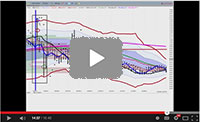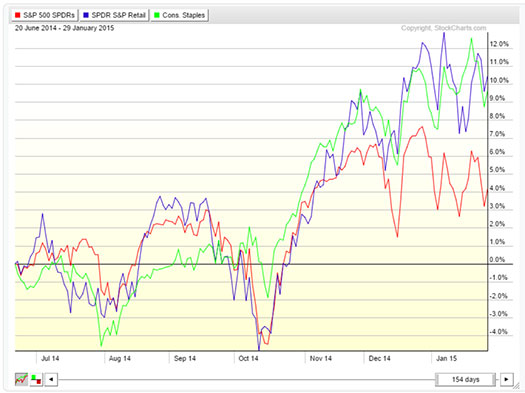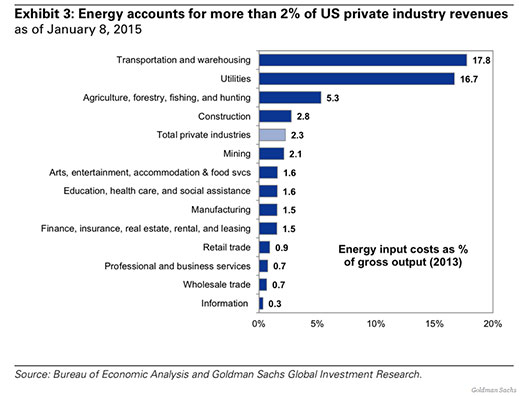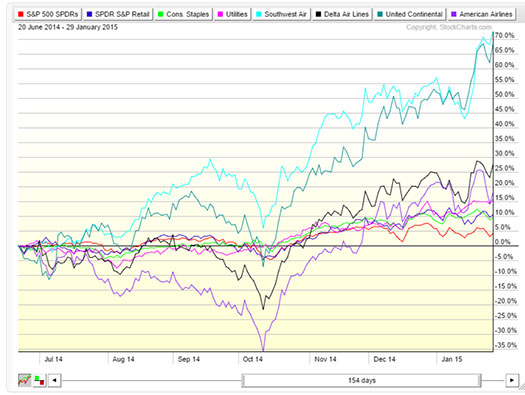Tip: Who Does Cheap Crude Really Help?
by D. R. Barton, Jr.
$700 EARLY REGISTRATION DISCOUNTS EXPIRE TODAY!
Register now to get your best price on our Sydney events.

The Peak Performance 101 workshop has been the core of Van Tharp's instruction for 25 years.
Plus, Dr. Tharp will be presenting his new Mental Strategies workshop and his Blueprint for Trading Success.
Read below for more information
Check the combo discounts if you would like to attend more than one Sydney event.

The Craftwork of Trading
By Ken Long
Click to view in browser for better formatting
Editor’s Note: In his workshops, Ken Long does teach a great deal about statistics and systematic thinking — but that’s not all. The following piece might broaden your perspective of understanding Ken’s “multi-disciplinary” approach to trading.
The style of trading that works best for me is a combination of discretion and rule based systems. Sometimes I start with a framework of rules and then apply some discretion in the gray area between the rules. I see this as mostly systematic trading with some limited discretion. In other circumstances I start with a discretionary reason to trade, such as a favorable reward to risk ratio in either direction and then add structured rules to govern risk, timing, position size, and exits. I think of this style as being artistic with the addition of structured discipline. I believe that both forms of trading are types of craft knowledge.
By craft knowledge I mean a body of knowledge that is informed by both theory and practice, requiring both domains to add value to the final mix. For me the theory of trading primarily helps me understand two areas 1) statistics that describe the price action and 2) the psychological interpretation of common technical indicators vs. the consensus interpretation found in trading literature. This combination of descriptive statistics and the mass psychology of the herd via indicators establishes a framework within which I can make disciplined routine professional judgments about reward to risk ratios. Operating within this framework has allowed me to identify a standard set of patterns for effective decision-making in all time frames that minimizes the emotional cost of making decisions under stress.
Making decisions under stress carries an emotional cost as we must consider the consequences of outcomes over which we have no control. We know that trading effectively requires us to take positions in moments of great uncertainty because the greatest potential rewards exist in these conditions of uncertainty. If we can manage our risk such that average losses are less than the average pay off on winning trades, we can develop reliable positive expectancy systems. The deeply ingrained aversion to losses, however, presents a continuous challenge to our emotional well-being. Learning how to deal with a routine and expected level of stress is a critical success factor in developing the emotional resilience required to stay in the effective trading zone as a professional.
I’m fond of using animal metaphors in trading and one of my favorites is the rhinoceros. Rhinos are blessed with an incredibly thick skin that protects them from all of the natural annoyances that bother other animals like flies and the sharp teeth of small carnivores. Meanwhile, their horns, their great size, and their strength ward off all but the most impetuous of meat eaters. The rhino’s combination of thick skin, power, and gentle nature allows him to operate quite successfully in his environment, untroubled by the stresses that plague other creatures without his unusual qualities.
I use the rhinoceros metaphor when I consider how I can improve my emotional resilience for the normal stresses of trading. Techniques like guided visualizations, meditation, biofeedback devices, regulated breathing, and identifying oncoming stressors before they wreak havoc on my mental state are ways of developing a thick skin. In addition, the use of statistics to look at performance over a large data set as opposed to dwelling on individual losses helps me maintain an even keel for trading. All of these techniques fall into the realm of the craftwork of trading, as do other routine tasks like reviewing individual trades, performing and recording Van’s Top Tasks of Trading, maintaining a trading journal, analyzing performance statistics from different systems, documenting my trading psychology, sharing results and reflections with trusted others to help triangulate multiple perspectives into my trading performance. These routine tasks help build up my emotional bank account so that I have resources available when the stress events naturally occur so that I can stay within the normal boundaries of psychological comfort even when trading short-term high volatility instruments.
Interestingly, I have come to find shorter-term trading to be less stressful than longer-term trading. Intraday, I am able make many more trades than I can in longer-term trades. In addition, each intraday trade has less time in trade and generates a smaller proportion of my overall results so the stress per trade is less. The more frequent results provide me ongoing feedback which allows me to determine much more rapidly when my choice of systems and decision-making are well in tune with the current rhythm of the market. When that feedback says my trading results are out of sync with the market, I know relatively quickly that I need to reduce my position size or trade frequency. Making these adjustments and adaptations in stride are also part of the craftwork of trading.
In other words, craftwork includes not just the theories of our systems and indicators and top-down view of the world that we apply to individual trades. Craftwork also includes the bottoms up inductive lessons we learn that come from putting beliefs into action and then committing to the study of our results so that we can learn by doing.
Society used to have a much deeper appreciation for the craft approach to work back in the Middle Ages when it dominated economic activity. In all of the productive trades, there was a normal progression from novice to apprentice to journeyman to master and finally to artist. When we worked with our hands as a species we knew that there was learning in the doing under the watchful eye of an experience guide. The workshop was the school and the work itself was the best teacher if one could learn to develop the watchful eye and the reflective mind that could record and integrate the lessons as we thought about the day’s work. Pure art could be found in the moment when the active seeing, doing, observing, reflecting and adapting all coexisted in the pure moment of creation when the boundaries between self and the world disappeared and the artist could be one with the art.
Experiencing such flow state is deeply satisfying and can be found in all of the crafts. As a craft in its own right, trading is no exception. I have found that when my primary goal is to trade well, I regularly experience moments of flow. I have also found that when my primary goal is to simply trade well, my results are better as a consequence.
In our day trading workshops, we explore specific components of the trading craft and practice the techniques of stalking, framing, sensing, managing, and exiting trades in ways that the organic craftwork can unfold under our steady hands and watchful eyes. We learn how to execute good trading techniques as parts of robust systems and how to perform the disciplined reflection that allow us to turn positive behaviors into stable habits. This kind of craft knowledge can only come from disciplined practice accompanied by a healthy respect for the craft. The high quality steps we make along the journey towards our ultimate destination in turn produces excellence.
The process continues after the workshops. We can continue to integrate our lessons learned by participating in our community of practice’s very supportive chat room. While further refining and extending learned techniques, continued participation in that community allows us to advance the body of knowledge - which we openly share to help others develop their craft skills.
Keep your risk measured and your powder dry so that you’re ready when opportunity knocks. Good trading!
About the Author: Dr. Ken Long retired from the Army as a Lieutenant Colonel and teaches at the U.S. Army Staff College. He is a proud father of three, a husband, teacher, student, martial artist and active trader. Ken also instructs dynamic trading workshops for the Van Tharp Institute.
Ken's next workshop is just around the corner, Day Trading Systems in March. Watch this video to hear two testimonials from students of Ken Long.
Workshops
Combo Discounts available for all back-to-back workshops!
See our workshop page for details.
Trading Tip

The Swissy Unpeg
Some Practical Lessons
by Gabriel Grammatidis
View in browser
Due to the sudden SNB unpeg last month, traders who were short the Swissy might have incurred losses — and in some cases “fatal” losses. Traders, however, could have avoided such losses easily had they been following some general FX guidelines - guidelines that cannot be repeated too often:
| • |
|
Don’t trade a pegged currency. (Corollary advice - Trade freely floating currencies.) |
| • |
|
Don’t trade an illiquid currency. (Stick with highly liquid pairs.) |
| • |
|
Don’t trade against the trend. (Trade with the trend.) |
| • |
|
Don’t trade high-risk low-profit ideas. (Find and trade only low-risk opportunities.)
|
Traders long the EURCHF pair who relied on the peg holding ignored all of the guidelines above. As a result, some of them (and even some funds) had to “bite the bullet” last month. Everybody can learn a number of lessons from this recent event including three specific areas this article is focusing on today — impact on FX brokerages, trading pegged pairs, and understanding FX instruments.
FX Brokerages Impact
It’s worth mentioning that for many months, most FX brokers had their clients’ interest in mind regarding CHF trading. Most had been warning their clients about the risks of the Swissy exposure and potential volatility. Many brokers had also taken the precautionary measure of increasing the minimum margin required for the CHF pairs from 1% to 5%. This change should have kept many clients out of the worst risk zone – and kept many brokerages out of trouble too.
Despite the sudden shakeup the SNB decision brought, the impact on the Forex Broker universe was relatively limited. Two brokers were affected the most by the recent SNB action - FXCM and Alpari (UK). Both brokers had a negative balance protection policy which means that clients could not lose more than the balance of their account (You can find a list of brokers that forgive negative balances here). FXCM has already balanced negative accounts related to this event.
Clients of FXCM and Alpari were also protected by the segregation of funds. This means that clients’ money was kept separate from the firms’ balance sheet as a protective measure - even in the bankruptcy of the broker. In the case of Alpari (which became insolvent), clients’ brokerage accounts were further legally protected by the UK’s government regulation for a deposit guarantee of up to 50 thousand Pounds.
Pegged FX Pairs
Are there other pegged currencies around? Yes, but only a few and FX traders should generally avoid trading them. None are very liquid: the Danish Krone, the Hong Kong Dollar and the Chinese Yuan Renminbi. Again, none of these currencies are attractive for active trading and should be avoided. (You can monitor which currencies are pegged with a little research at websites like this one.)
FX Instruments
Forex offers traders a number of advantages and a primary benefit is a good number of tradable instruments or vehicles. The list of Forex instruments below is generally ordered from better longer term holding periods to shortest term (from position to swing to intraday trading):
| • |
|
Bank account denominated in a foreign exchange currency (eg CHF) |
| • |
|
Investment fund denominated in a foreign exchange currency (eg Bond fund in CHF) |
| • |
|
Currency swap (if provided by your bank) |
| • |
|
Currency ETF (eg leveraged CHF) |
| • |
|
Currency Options (eg EURCHF put with maturity in 2 years) |
| • |
|
Currency Futures or |
| • |
|
FX spot on margin |
Some of the above instruments will better fit what you want to achieve in one situation while in another situation, a different type might be more suitable. The advantages and disadvantages of each vehicle over another can be both obvious and subtle so you should understand your objectives very thoroughly before considering the appropriate instruments for executing a strategy.
Short Term Pain, Long Term Gain?
As with many sudden events of this kind, initial effects may not be pleasant but the occurrence can turn out to be healthy for longer term development. Ultimately, the SNB unpeg will probably promote more professionalism in the Forex trading industry. Too many market actors may have become too carefree and complacent after years of good business so the shock was indeed a very healthy development at the industry and market level. At the personal level, the Swissy unpeg was a remember for FX traders to focus on trading with the trend and trade the liquidity of currencies.
In upcoming articles, I will give some practical information on broker selection and also write about trading various instruments based on some higher time-frame patterns that are evolving.
All the best,
Gabriel Grammatidis
If you are interested in learning more about trading Forex or investing in currencies, read Gabriel’s article Top Ten Reasons to Trade Forex. You can also find a good list of resources and watch his videos at https://vanktharp.com/workshops/forex.asp
About the Author: Gabriel Grammatidis is a successful full-time trader and graduate of the Super Trader program. He has extensive experience trading Forex and shares his knowledge at his Forex and Live Forex Trading workshops, held regularly at VTI. Gabriel can be reached at gabriel "at" vantharp.com.
Video
Join Ken Long in Just A Few Weeks for His Dynamic Day Trading Systems Workshop! $700 Discount Expires Soon.
One setup, for multiple trades: In this 16 minute video, Ken Long explains a series of trades he took over the last two days using a number of his market methodologies. First, he gives a thorough review of his overall market health check chart, then provides a swing trade setup, and finally shows how a specific chart pattern offered a low risk opportunity. You can see and hear how these different elements fit together for a profitable day trade on February 2 that then evolved into a swing trade overnight. Then, on February 3, he closed the swing trade while the chart revealed another RLCO intra-day trade opportunity in the opposite direction.

Join Ken for his popular Day Trading Workshop, followed by two days of live trading. Click here to learn more.
To register or to see our full workshop schedule, click here.
Trading Tip

Who Does Cheap Crude Really Help?
by D. R. Barton, Jr.
View in browser
Conventional wisdom can be tricky. Whether or not we rely on conventional wisdom, it has some effects on our lives. Webster’s defines it as “opinions or beliefs that are accepted by most people”. Such a pervasive knowing can help a culture use mental shortcuts, act as a homogeneous whole, etc.
Of course sometimes, conventional wisdom is just wrong - what most folks believe just doesn’t hold up to scrutiny. We saw an example of this in last week’s article where we debunked the conventional wisdom about the oil rig count. After some analysis, we saw that a rapidly declining rig count in the U.S. had not led to a reduction in crude production. In fact – just the opposite has been happening.
Recently, I’ve read about a dozen articles and seen many TV interviews where analysts opined about which industries would benefit from lower crude prices and subsequently, where investors should place their capital. Today we’ll dig into another conventional wisdom regarding the drop in oil and find a rampant fallacy in the trading and investing community.
What Conventional Wisdom Says About Lower Oil Prices
A pervasive theme emerged last fall and has persisted since then that goes like this
-
Lower fuel prices mean that the consuming public will have to pay less for gas.
- That means more money in Joe and Jane Sixpack’s pockets so they’ll be spending more.
- And since gas is cheap, they’ll be driving more, so they’ll visit the discount stores (Walmart, Target, Dollar General/Tree) and low cost restaurants more often.
- So invest in retail and consumer staples.
How has this then been working in the market? If we look at the retail sector or consumer staples sector versus the S&P 500 from crude’s recent high (June 20, 2014) until it’s low (Jan 29, 2015), we see that both of those sectors did outperform the S&P.

Click here to view a larger image
That’s the power of conventional wisdom - this supposed common knowledge has played out in the market.
Where Is the Real Money Saved with Lower Crude Prices?
So let’s turn to research to see how conventional wisdom plays out vs. the broader reality. This very informative Goldman Sachs chart shows who really saves money when fuel prices drop.

As we can see, transportation companies (like airlines) and utilities are the big beneficiaries from a drop in oil prices. Let’s add those businesses to our percent gain chart for the same time-frame.

Click here to view a larger image
Looking at the pink line, we see that utilities definitely outperformed retail and consumer staples stocks by about 50% (a 15% rise vs. a 10% rise). Since we have no airline ETF, I posted four individual airline stocks in the chart. As you can see, individually and as a group, the airline stocks outperformed all other lines of the chart by a large factor. It’s not even close.
To be fair, the conventional wisdom about gas prices regards consumer behavior and the Goldman Sachs chart considers energy consumption at companies. When oil prices plummeted, both consumers and businesses have been affected but clearly, the price drop has most directly benefited the market sectors that consume a lot of fuel.
So if you believe that the oil supply glut will continue for the next quarter or two, you might position your investing dollars to get the biggest bang for the buck.
Your thoughts and comments are always welcome - please send them to drbarton “at” vantharp.com — I always enjoy hearing from you!
Great Trading,
D. R.
About the Author: A passion for the systematic approach to the markets and lifelong love of teaching and learning have propelled D.R. Barton, Jr. to the top of the investment and trading arena. He is a regularly featured analyst on Fox Business’ Varney & Co. TV show (catch him most Thursdays between 12:30 and 12:45), on Bloomberg Radio Taking Stock and MarketWatch’s Money Life Show. He is also a frequent guest analyst on CNBC’s Closing Bell, WTOP News Radio in Washington, D.C., and has been a guest on China Central Television - America and Canada’s Business News Network. His articles have appeared on SmartMoney.com MarketWatch.com and Financial Advisor magazine. You may contact D.R. at "drbarton" at "vantharp.com".
 Enter the Matrix Contest
Enter the Matrix Contest
for a chance to win a free workshop!
We want to hear about the one most profound insight that you got from reading Van's new book, Trading Beyond the Matrix, and how it has impacted your life. If you would like to enter, send an email to [email protected].
If you haven't purchased Trading Beyond the Matrix yet, click here.
For more information about the contest, click here.
Ask Van...
Everything we do here at the Van Tharp Institute is focused on helping you improve as a trader and investor. Consequently, we love to get your feedback, both positive and negative!
Send comments or ask Van a question by clicking here.
Also, Click here to take our quick, 6-question survey.
Back to Top
Contact Us
Email us at [email protected]
The Van Tharp Institute does not support spamming in any way, shape or form. This is a subscription based newsletter.
To change your e-mail Address, e-mail us at [email protected].
To stop your subscription, click on the "unsubscribe" link at the bottom left-hand corner of this email.
How are we doing? Give us your feedback! Click here to take our quick survey.
Call us at: 800-385-4486 * 919-466-0043 * Fax 919-466-0408
SQN® and the System Quality Number® are registered trademarks of the Van Tharp Institute and the International Institute of Trading Mastery, Inc.
Be sure to check us out on Facebook and Twitter!


Back to Top